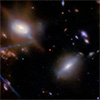| Mar 26, 2025 |
Astronomers discovered bright hydrogen emissions from an ancient galaxy, puzzling researchers over how this light pierced the universe’s early hydrogen fog.
|
|
(Nanowerk News) Using the unique infrared sensitivity of NASA’s James Webb Space Telescope, researchers can examine ancient galaxies to probe secrets of the early universe. Now, an international team of astronomers has identified bright hydrogen emission from a galaxy in an unexpectedly early time in the universe’s history. The surprise finding is challenging researchers to explain how this light could have pierced the thick fog of neutral hydrogen that filled space at that time.
|
|
This research was published in the journal Nature (“Witnessing the onset of reionization through Lyman-α emission at redshift 13”).
|
 |
| This image shows the galaxy JADES GS-z13-1 (the red dot at center), imaged with NASA’s James Webb Space Telescope’s NIRCam (Near-Infrared Camera) as part of the JWST Advanced Deep Extragalactic Survey (JADES) program. These data from NIRCam allowed researchers to identify GS-z13-1 as an incredibly distant galaxy, and to put an estimate on its redshift value. Webb’s unique infrared sensitivity is necessary to observe galaxies at this extreme distance, whose light has been shifted into infrared wavelengths during its long journey across the cosmos. (Image: NASA, ESA, CSA, JADES Collaboration, B. Robertson (UC Santa Cruz), B. Johnson (CfA), S. Tacchella (Cambridge), P. Cargile (CfA), J. Witstok (University of Cambridge/University of Copenhagen), P. Jakobsen (University of Copenhagen), A. Pagan (STScI), M. Za)
|
|
The Webb telescope discovered the incredibly distant galaxy JADES-GS-z13-1, observed to exist just 330 million years after the big bang, in images taken by Webb’s NIRCam (Near-Infrared Camera) as part of the James Webb Space Telescope Advanced Deep Extragalactic Survey (JADES). Researchers used the galaxy’s brightness in different infrared filters to estimate its redshift, which measures a galaxy’s distance from Earth based on how its light has been stretched out during its journey through expanding space.
|
|
The NIRCam imaging yielded an initial redshift estimate of 12.9. Seeking to confirm its extreme redshift, an international team lead by Joris Witstok of the University of Cambridge in the United Kingdom as well as the Cosmic Dawn Center and the University of Copenhagen in Denmark, then observed the galaxy using Webb’s NIRSpec (Near-Infrared Spectrograph) instrument.
|
|
In the resulting spectrum the redshift was confirmed to be 13.0. This equates to a galaxy seen just 330 million years after the big bang, a small fraction of the universe’s present age of 13.8 billion years old. But an unexpected feature stood out as well: one specific, distinctly bright wavelength of light, known as Lyman-alpha emission radiated by hydrogen atoms. This emission was far stronger than astronomers thought possible at this early stage in the universe’s development.
|
|
“The early universe was bathed in a thick fog of neutral hydrogen,” explained Roberto Maiolino, a team member from the University of Cambridge and University College London. “Most of this haze was lifted in a process called reionization, which was completed about one billion years after the big bang. GS-z13-1 is seen when the universe was only 330 million years old, yet it shows a surprisingly clear, telltale signature of Lyman-alpha emission that can only be seen once the surrounding fog has fully lifted. This result was totally unexpected by theories of early galaxy formation and has caught astronomers by surprise.”
|
|
Before and during the era of reionization, the immense amounts of neutral hydrogen fog surrounding galaxies blocked any energetic ultraviolet light they emitted, much like the filtering effect of colored glass. Until enough stars had formed and were able to ionize the hydrogen gas, no such light — including Lyman-alpha emission — could escape from these fledgling galaxies to reach Earth. The confirmation of Lyman-alpha radiation from this galaxy, therefore, has great implications for our understanding of the early universe.
|
|
“We really shouldn’t have found a galaxy like this, given our understanding of the way the universe has evolved,” said Kevin Hainline, a team member from the University of Arizona. “We could think of the early universe as shrouded with a thick fog that would make it exceedingly difficult to find even powerful lighthouses peeking through, yet here we see the beam of light from this galaxy piercing the veil. This fascinating emission line has huge ramifications for how and when the universe reionized.”
|
|
The source of the Lyman-alpha radiation from this galaxy is not yet known, but may include the first light from the earliest generation of stars to form in the universe. “The large bubble of ionized hydrogen surrounding this galaxy might have been created by a peculiar population of stars — much more massive, hotter and more luminous than stars formed at later epochs, and possibly representative of the first generation of stars,” said Witstok. A powerful active galactic nucleus, driven by one of the first supermassive black holes, is another possibility identified by the team.
|


